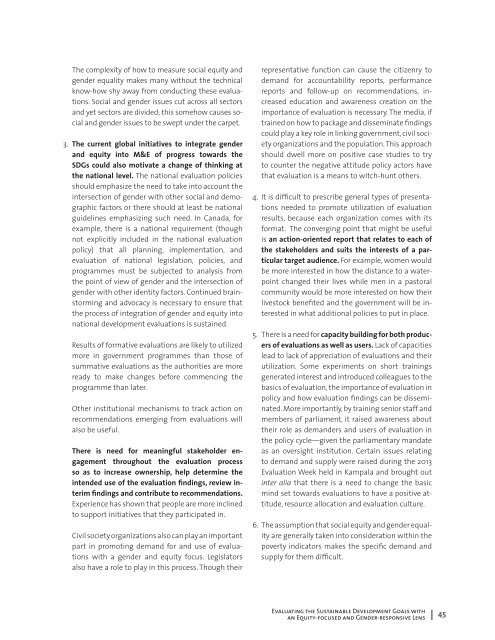NO ONE LEFT BEHIND
NY-Events-Report_WEB
NY-Events-Report_WEB
You also want an ePaper? Increase the reach of your titles
YUMPU automatically turns print PDFs into web optimized ePapers that Google loves.
The complexity of how to measure social equity and<br />
gender equality makes many without the technical<br />
know-how shy away from conducting these evaluations.<br />
Social and gender issues cut across all sectors<br />
and yet sectors are divided; this somehow causes social<br />
and gender issues to be swept under the carpet.<br />
3. The current global initiatives to integrate gender<br />
and equity into M&E of progress towards the<br />
SDGs could also motivate a change of thinking at<br />
the national level. The national evaluation policies<br />
should emphasize the need to take into account the<br />
intersection of gender with other social and demographic<br />
factors or there should at least be national<br />
guidelines emphasizing such need. In Canada, for<br />
example, there is a national requirement (though<br />
not explicitly included in the national evaluation<br />
policy) that all planning, implementation, and<br />
evaluation of national legislation, policies, and<br />
programmes must be subjected to analysis from<br />
the point of view of gender and the intersection of<br />
gender with other identity factors. Continued brainstorming<br />
and advocacy is necessary to ensure that<br />
the process of integration of gender and equity into<br />
national development evaluations is sustained.<br />
Results of formative evaluations are likely to utilized<br />
more in government programmes than those of<br />
summative evaluations as the authorities are more<br />
ready to make changes before commencing the<br />
programme than later.<br />
Other institutional mechanisms to track action on<br />
recommendations emerging from evaluations will<br />
also be useful.<br />
There is need for meaningful stakeholder engagement<br />
throughout the evaluation process<br />
so as to increase ownership, help determine the<br />
intended use of the evaluation findings, review interim<br />
findings and contribute to recommendations.<br />
Experience has shown that people are more inclined<br />
to support initiatives that they participated in.<br />
Civil society organizations also can play an important<br />
part in promoting demand for and use of evaluations<br />
with a gender and equity focus. Legislators<br />
also have a role to play in this process. Though their<br />
representative function can cause the citizenry to<br />
demand for accountability reports, performance<br />
reports and follow-up on recommendations, increased<br />
education and awareness creation on the<br />
importance of evaluation is necessary. The media, if<br />
trained on how to package and disseminate findings<br />
could play a key role in linking government, civil society<br />
organizations and the population. This approach<br />
should dwell more on positive case studies to try<br />
to counter the negative attitude policy actors have<br />
that evaluation is a means to witch-hunt others.<br />
4. It is difficult to prescribe general types of presentations<br />
needed to promote utilization of evaluation<br />
results, because each organization comes with its<br />
format. The converging point that might be useful<br />
is an action-oriented report that relates to each of<br />
the stakeholders and suits the interests of a particular<br />
target audience. For example, women would<br />
be more interested in how the distance to a waterpoint<br />
changed their lives while men in a pastoral<br />
community would be more interested on how their<br />
livestock benefited and the government will be interested<br />
in what additional policies to put in place.<br />
5. There is a need for capacity building for both producers<br />
of evaluations as well as users. Lack of capacities<br />
lead to lack of appreciation of evaluations and their<br />
utilization. Some experiments on short trainings<br />
generated interest and introduced colleagues to the<br />
basics of evaluation, the importance of evaluation in<br />
policy and how evaluation findings can be disseminated.<br />
More importantly, by training senior staff and<br />
members of parliament, it raised awareness about<br />
their role as demanders and users of evaluation in<br />
the policy cycle—given the parliamentary mandate<br />
as an oversight institution. Certain issues relating<br />
to demand and supply were raised during the 2013<br />
Evaluation Week held in Kampala and brought out<br />
inter alia that there is a need to change the basic<br />
mind set towards evaluations to have a positive attitude,<br />
resource allocation and evaluation culture.<br />
6. The assumption that social equity and gender equality<br />
are generally taken into consideration within the<br />
poverty indicators makes the specific demand and<br />
supply for them difficult.<br />
Evaluating the Sustainable Development Goals with<br />
an Equity-focused and Gender-responsive Lens 45


